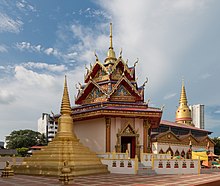معبد چایامانکالارام
| معبد چایامانکالارام วัดไชยมังคลาราม | |
|---|---|
 نمای جلو معبد | |
 | |
| دین | |
| وابستگی | بودیسم |
| بخش | ناحیه شمال شرقی جزیره پنانگ |
| مکان | |
| مکان | پولائو تیکوس |
| ایالت | پنانگ |
| کشور | مالزی |
| مختصات | ۵°۲۵′۵۴٫۴۷۹″ شمالی ۱۰۰°۱۸′۴۸٫۲۷۶″ شرقی / ۵٫۴۳۱۷۹۹۷۲°شمالی ۱۰۰٫۳۱۳۴۱۰۰۰°شرقی |
| معماری | |
| گونه | معبد تایلندی |
| بنیانگذار | Phra Phorthan Kuad[۱][۲] |
| بنیانگذاری | ۱۸۴۵[۱][۲][۳] |
معبد چایامانکالارام (به انگلیسی: Wat Chayamangkalaram)(تای: วัดไชยมังคลาราม; rtgs: Wat Chaiyamangkhalaram) (هم چنین از آن به معبد بودایی چایامانکالارام نام برده میشود) یک معبد تایلندی در پولائو تیکوس، حومۀ جرج تاون در ایالت پنانگ، مالزی است. معبد در خیابان کلاوی، نزدیک معبد برمه ای دامیکاراما واقع شدهاست.[۴] این معبد قدیمیترین معبد مالزیاییهای تایلندیتبار در این ایالت است. معبد به کانونی برای برگزاری فستیوالهای تایلندی سونگکران و لوی کراتونگ در حومهٔ شهر و مراسم سالیانه روز بودا در شهر تبدیل شدهاست.[۵][۶]
تاریخچه[ویرایش]
در طی دوران شهرکهای تنگه، بعد از اینکه ملکه ویکتوریا قطعه زمینی در جرج تاون را به دو جامعه برمهای و سیامی اهداء کرد، در سال ۱۷۹۵ این زمین جهت ساخت معبد تسطیح گردید.[۱][۳][۷][۸] در سال ۱۸۳۰، در پنانگ که در آن دوران جمعیتی بالغ بر ۴۰,۰۰۰ نفر داشت، حدود ۶۴۸ نفر برمهای و سیامی زندگی می کردند.[۱]
پانویس[ویرایش]
مشارکتکنندگان ویکیپدیا. «Wat Chayamangkalaram». در دانشنامهٔ ویکیپدیای انگلیسی.
منابع[ویرایش]
- ↑ ۱٫۰ ۱٫۱ ۱٫۲ ۱٫۳ Khoo Salma Nasution (2012). "Exploring Shared History, Preserving Shared Heritage: Penang's Links to a Siamese Past [The Siamese community and Buddhism in Penang]" (PDF). Journal of the Siam Society. Siamese Heritage. 100: 313 [10/15]. Archived from the original (PDF) on 23 March 2019. Retrieved 23 March 2019.
The site of the Pulau Tikus Siamese Temple, the oldest Siamese temple in Penang, was cleared in 1795 and a Burmese temple was established there since the early nineteenth century. Around 1830, the Siamese and Burmese community totalled 648 out of a population of about forty thousand. In 1845, during the term of W. J. Butterworth as governor of the Straits Settlements, the East India Company made a grant of land to the Burmese and Siamese inhabitants to be jointly held by Nongmay and Boonkhan as representatives of the Burmese community, and Nankayo and Boonsoon as representatives of the Siamese community. The first head priest was Phra Kuad. Inscriptions showed that the building of the temple had been largely due to the philanthropic efforts of Chinese Buddhists. This temple was renamed Wat Chaiya Mangkalaram in 1948, and its famous Reclining Buddha statue was unveiled by the Thai king and queen before a crowd of 5,000 during their official trip to Malaya in 1962.
- ↑ ۲٫۰ ۲٫۱ "A Tale of Three Temples – The Temples of Pulau Tikus". Penang Free Sheet. Archived from the original on 23 March 2019. Retrieved 23 March 2019.
Across the street, closer than a stone's throw away, is the Wat Chayamangkalaram. Much like its Burmese neighbour, the temple is a feast of colours – particularly gold. Queen Victoria first granted the land to the Buddhist community in 1845 to promote trade between the British Empire and Siam. A thing of beauty, if not dominance, the reclining Buddha is the temple's centrepiece and main place of worship. However, as well as serving as a stunning backdrop for people praying and burning incense, it also serves as columbarium. A visitor can walk completely around the statue and, at the back of the statue, can view where the urn of the cremated are housed. One thing to notice when visiting the temple is the offerings made at different shrines. Of note, you can sometimes find a bowl of laksa sitting at the base of a shrine. It is not unusual for offerings of food to appear at Buddhist places of worship, but laksa supposedly has a specific relevance. The first monk in Wat Chaiyamangkalaram was Phorthan Kuat, a Theravada Buddhist monk from Siam also known as the 'Powerful Monk'. It is said that he was very fond of asam laksa and, to this day, the famous local dish is still offered to his shrine by devotees.
- ↑ ۳٫۰ ۳٫۱ "Buddhist temples in Penang". New Straits Times. 24 May 2018. Retrieved 24 March 2019 – via PressReader.
- ↑ Joshua Eliot; Jane Bickersteth (2002). Malaysia Handbook: The Travel Guide. Footprint Handbooks. p. 160. ISBN 978-1-903471-27-2.
- ↑ Arnold Loh (14 April 2015). "Water Festival celebrations off to a soaking start at Burmese Buddhist temples". The Star. Retrieved 23 March 2019.
Revellers at the Water Festival "fired" at visitors with their water guns at the Wat Chayamangkalaram and Dhammakirama Burmese Buddhist temples in Burma Lane, where the three day celebrations began yesterday.
- ↑ "Five million Malaysians celebrate Songkran and Good Friday". The Sun. 13 April 2017. Retrieved 23 March 2019.
Hundreds of revellers thronged Wat Chayamangkalaram in Pulau Tikus here to usher in the Thai New Year or more popularly known as Songkran.
- ↑ Prentice Hall (1993). Indonesia, Malaysia & Singapore Handbook. Trade & Trade & Travel Publications ; New York, NY. p. 140.
- ↑ Jin Seng Cheah (19 February 2013). Penang 500 Early Postcards. Editions Didier Millet. p. 191. ISBN 978-967-10617-1-8.
